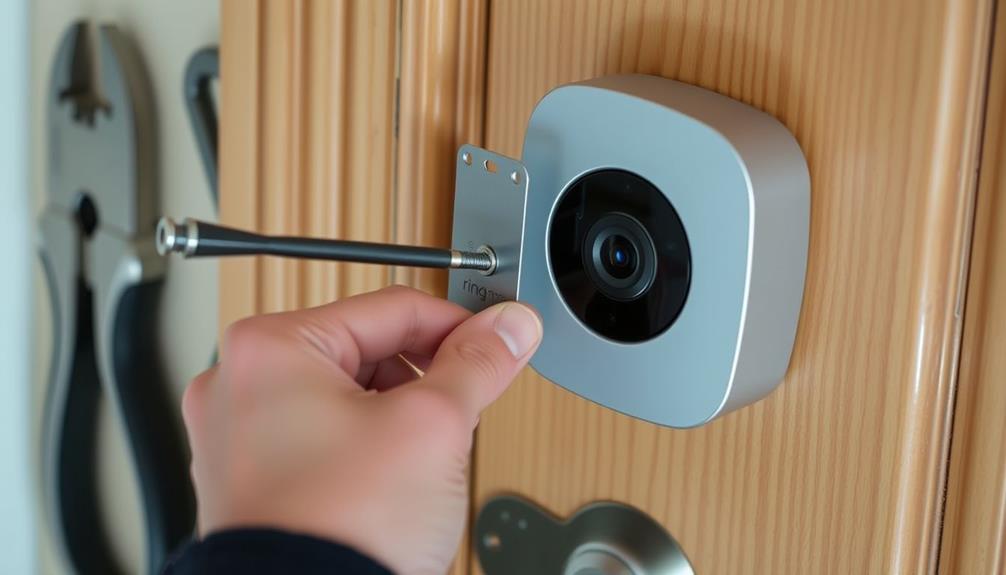To lessen sensitivity on your Ring Doorbell, start by adjusting the motion sensitivity slider in the Ring app. Move it towards MIN to reduce alerts from small movements. You can also create specific motion zones to focus detection on important areas and exclude high-traffic spots. Enabling Smart Alerts will sort notifications to highlight human movement. Remember to save your changes in the app! If you encounter issues, consider exploring other features and community suggestions to enhance your doorbell settings for a better experience. If adjusting the motion sensitivity slider and setting up specific motion zones is not enough to reduce Ring Doorbell sensitivity, try exploring other features like customizable motion schedules or adjustable motion frequency settings. Additionally, don’t hesitate to seek tips and tricks from the Ring community on how to further reduce ring doorbell sensitivity and tailor your settings for optimal performance. If you continue to struggle with reducing ring doorbell sensitivity, experimenting with the customizable motion schedule and motion frequency settings can help fine-tune the sensitivity of your Ring Doorbell. Remember, utilizing the Ring community for additional insights can be valuable for personalizing and enhancing your home security system. For further assistance and expert advice on reducing sensitivity, don’t hesitate to contact Ring customer support.
Key Takeaways
- Adjust the motion sensitivity slider in the Ring app to a lower setting for fewer false alerts from minor movements.
- Use the Motion Wizard in the app for a quick reset to default sensitivity settings.
- Customize motion zones to focus detection on specific areas, minimizing unnecessary notifications from high-traffic zones.
- Enable Smart Alerts to filter notifications, focusing only on human movement for more relevant alerts.
Understanding Motion Sensitivity
To effectively manage alerts from your Ring doorbell, it's essential to grasp how motion sensitivity settings work. You can adjust these settings using a slider in the Ring app, allowing you to choose between MIN and MAX sensitivity levels.
Setting the sensitivity to MIN detects fewer movements, which helps reduce false alerts from minor activities like passing cars or animals. This setting is ideal if you want to limit unnecessary notifications. Additionally, understanding the latest garage door openers can help enhance your home security system overall.
On the other hand, if you set the sensitivity to MAX, your doorbell will capture all movements within its detection range, providing maximum awareness. However, this can lead to an overload of notifications, which may become overwhelming. To find the right balance, you'll want to experiment with the slider until you reach a level that suits your needs.
Access the Motion Settings section in the app to make these adjustments easily. If you ever need to reset your sensitivity settings to their original defaults, the app's Motion Wizard can assist you in doing so.
Adjusting Motion Zones

Adjusting the motion zones on your Ring doorbell lets you focus detection on specific areas, greatly reducing alerts from irrelevant movements. This is especially useful in busy environments where other factors, like pets or passing cars, could trigger unnecessary notifications.
To get started, open the Ring app and navigate to your device settings. From there, select "Motion Zones" to customize areas where motion detection occurs. This feature allows you to create up to three distinct motion zones, so you can tailor the sensitivity based on the significance of each area.
You might also consider how top water parks for families utilize designated areas for safety and enjoyment, which can inspire your adjustments. It's wise to exclude high-traffic zones like busy streets or sidewalks to minimize unnecessary alerts.
Additionally, consider the placement of your Ring doorbell; avoid reflective surfaces or other environmental factors that might trigger false alerts. After you've made your adjustments, don't forget to save changes in the app. This step is vital for effectively implementing your new settings and enhancing your doorbell's performance.
Configuring Smart Alerts

Configuring Smart Alerts in the Ring app allows you to fine-tune notifications, ensuring you're only alerted to human movement while ignoring distractions like pets or passing cars.
By utilizing the motion sensitivity slider, you can adjust motion detection settings and reduce alerts for non-relevant activity, creating a more tailored experience. This customization not only enhances your security but also reduces unnecessary interruptions, leading to a more peaceful home environment.
Additionally, with AI-driven solutions in smart technology, you can expect continuous improvements in detection accuracy, helping you to manage alerts effectively AI in Cybersecurity.
To customize your settings effectively, consider these steps:
- Enable Smart Alerts: This feature filters notifications based on the type of movement detected, focusing on what really matters.
- Adjust Motion Zones: Set specific areas for motion detection, so you're only notified about relevant activity in critical zones.
With these strategies, you can optimize the notifications you receive, ensuring that each alert is meaningful and contributes to your overall security.
Troubleshooting Common Issues

Excessive alerts can be frustrating, but troubleshooting common issues with your Ring doorbell can help restore peace of mind.
Start by adjusting the motion sensitivity in the Motion Settings of the Ring app. Lowering the sensitivity slider to MIN can greatly reduce alerts caused by minor movements, while MAX captures everything, including vehicles.
If you've adjusted sensitivity but still receive too many notifications, consider defining a geometric motion zone. This focuses detection on specific areas, minimizing unnecessary alerts.
You can also utilize features like Person Alerts and Smart Alerts to refine what triggers notifications.
If you need to reset your sensitivity settings, the Motion Wizard in the app can quickly restore the original configuration.
Additionally, keep your Ring app updated; improvements in software can enhance performance and sensitivity settings.
Make sure you regularly check and adjust your alert notifications based on your needs.
Community Support and Resources

Many users find valuable support and insights within the Ring community when it comes to optimizing sensitivity settings on their doorbells. Engaging with fellow users allows you to discover effective ways to adjust your motion sensitivity settings and reduce false alerts.
The community serves as a platform where you can discuss your experiences, seek advice, and learn from others facing similar issues.
Here are some resources you can explore:
- Troubleshooting Guides: Access links shared by users that specifically address motion sensitivity settings.
- Community Discussions: Join conversations where users share experiences about adjusting motion alerts and making the most of the Ring app's advanced settings.
Frequently Asked Questions
How Do I Adjust the Sensitivity on My Ring Security Camera?
To adjust the sensitivity on your Ring security camera, you'll need to use the Ring app.
First, open the app and select your device.
Then, go to the "Motion Settings" section.
You'll find a sensitivity slider there; move it to your desired level—MIN for fewer detections or MAX for maximum coverage.
If you want to reset it, the Motion Wizard feature can help you get back to the original settings easily.
Can You Adjust the Sensor on a Ring Doorbell?
Absolutely, you can think of your Ring Doorbell's sensor like a finely tuned musical instrument.
You'll find you can adjust its sensitivity through the Ring app. Simply engage with the Motion Settings section, where you can choose between MIN and MAX settings.
By customizing this, you can guarantee it picks up the movements that matter most to you while tuning out those pesky distractions.
It's all about finding the perfect balance for your needs!
How Do I Turn off the Motion Sensor on My Ring Doorbell?
To turn off the motion sensor on your Ring doorbell, just open the Ring app and select your doorbell device.
Go to the "Motion Settings" section, where you can easily disable motion alerts. This means you won't get notifications for detected motion, but the doorbell will still record video.
You can also set specific time schedules for when the motion sensor should be active or inactive, giving you more control over your security.
How to Change Motion Alerts on Ring?
Changing motion alerts on your Ring doorbell is like fine-tuning an instrument; you want it to play just right.
Open the Ring app and select your device from the dashboard.
Head to "Motion Settings" where you can adjust the sensitivity slider.
You can also enable "Smart Alerts" to filter notifications for human movement only.
Don't forget to schedule alerts for specific times, and always save your changes to make them effective immediately.
Conclusion
By reducing the sensitivity on your Ring Doorbell, you can enjoy more peace of mind without unnecessary alerts.
Did you know that nearly 30% of homeowners experience alarm fatigue due to constant notifications?
By fine-tuning your motion settings, you can focus on what truly matters, ensuring you only get alerts when it's really important.
You'll not only enhance your home security but also reclaim your peace of mind, making your experience with technology more enjoyable.









